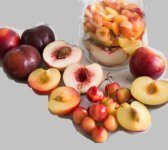A team of Clemson University researchers worked on “ Preventative sanitation measures for the elimination of Listeria monocytogenes biofilm in critical postharvest sites” (https://www.centerforproducesafety.org/researchproject/429/awards/Preventive_sanitation_measures_for_the_elimination_of_Listeria_monocytogenes_biofilms_in_critical_postharvest_sites.html) . They looks at difficult-to-sanitize micro-environments within a packinghouse where bacteria may inhabit that could serve as reservoirs. The study investigated biofilm impact on organism survival. The effect of material used in packaging line such as porous surface on biofilm formation is being investigated. Co-Principal Investigator - Claudia Ionita said “We’re discovering that certain materials actually favor biofilm attachment more than others,... “That could be very helpful for the brush industry or the peach packers.” The plan is to inoculate the surfaces m with Listeria and allow biofilms to form. The researchers will then treat the biofilm with various concentrations of commercial packinghouse sanitizers using different contact times and temperatures to gauge Listeria die-off. @ https://www.centerforproducesafety.org/article/151/Research_examines_antilisterial_fruit_coatings.html
Research Study: Preventive sanitation measures for the elimination of Listeria monocytogenes in biofilms
Listeria monocytogenes is an important foodborne pathogen commonly found in the environment. Recent Listeria foodborne outbreaks have been linked to fresh produce including stone fruits. Contamination of stone fruits is problematic since these products are usually consumed without heating. In addition, some surfaces associated with packing operations are inherently difficult to sanitize. In the proposed research, these surfaces will be characterized and inoculated with Listeria monocytogenes in fluid chambers for biofilm formation. Biofilms will be treated with sanitizers commonly used in the stone fruit packing industry. Results from this study will provide improved pathogen control in addition to the basic good agricultural practices, thereby helping fruit industry to produce safer produce for human consumption.
Technical Abstract
The number of human outbreaks associated with foodborne pathogens contaminating fresh produce has increased in the past decade. Stone fruits such as peaches and nectarines are usually consumed raw but these fruits were considered ‘safe ‘since they had not been implicated in major human outbreaks. In 2014, a stone fruit packing company issued the first recall of certain stone fruits because of concern about contamination with Listeria monocytogenes. Although limited with only 2 illnesses, this outbreak highlighted the potential of L. monocytogenes to cause outbreaks via foods that had been considered unlikely vehicles for this pathogen. The packing house is an open environment, where raw materials, products, and workers are introduced continuously in the packing season. In addition, because of the specific operations, surfaces and equipment may present topographical features, increased roughness, or difficult-to-clean areas which can lead to colonization by background microflora and foodborne pathogens. We hypothesize that these critical areas can have an important role in microbial retention, and promote formation of biofilms. In this project, we propose to investigate critical microenvironments where bacteria can reside and serve as reservoirs. These critical areas will be identified directly in the packing house in collaboration with plant management (California), through topographical measurements, and microbiological swabbing. These critical areas will be recreated as fabricated surfaces for laboratory testing regarding potential for biofilm formation (Objective 1). Engineered surfaces will be inoculated L. monocytogenes and allowed to form biofilms in flow-through enclosures (Objective 2). These biofilms will be treated with sanitizers commonly used in the packing house such as chlorine, QUAT and an organic sanitizer. Temperature, concentration, and contact time will be optimized for biofilm inactivation. In Objective 2, we will also test if sanitizers selected for this study meet or exceed EPA requirements for hard surfaces other than stainless steel that can be found in the packing house. We will use in our experiments hard non stainless-steel surfaces fabricated in collaboration with the packing houses, such as wood. In addition to identifying problematic areas, biofilms will be inactivated with commonly used sanitizers and optimal conditions will be determined regarding sanitizer concentration and contact time. This project addresses CPS Part 1.1.3. Listeria monocytogenes preventive controls -cleaning & sanitation/ interventions.

